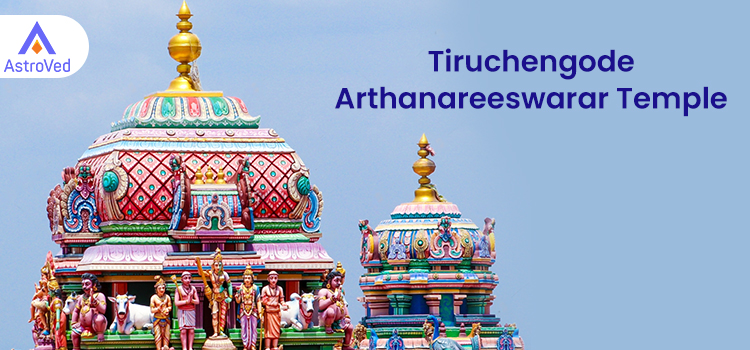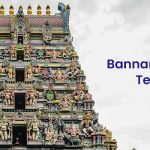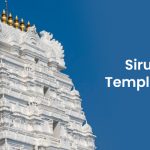The Arthanāreeswarā temple, also called Thirukodimāda Chenkundrūr, is an ancient Hindu temple in Tiruchengode, Tamil Nadu. The temple enshrines Arthanāreeswarā, the androgynous form of Lord Shiva, where he and his consort Goddess Parvati form two halves of a whole. The deity here is also called Mādhorubāgan and Ammaiyappan (mother-father).
This temple is also one among the 275 Paadal Petra Sthalams revered by Shaivite saints in their Thevaram hymns. Both Thirugnansambandar and Arunagirinathar have written hymns praising this temple. In the Tamil epic, Silappathikaram, the place is referred to as ‘Neduvelkundru’.
The temple also forms the subject of a popular composition by Muthuswami Dīkshitar, called Arthanāreeshwaram, in Kumudakriya Ragam.
Major renovations took place during the rule of the Chola, Pandya, and Nayak kings. A British colonial officer, Davis, also made some renovations. One can see his image in the Mukkoottu Vinayagar temple.
The Legend Behind the Temple
Adi Kesava Perumāl, a form of Vishnu worshipped here, supposedly told Parvati (Shiva’s consort) about the Kedara Gowri Vratam to help her unite with Shiva as Ardhanareeswarar.
Brahma, Indra, and Sage Bhringi once visited Kailasa to worship Shiva. Everyone except Bhringi paid their respects to Parvati before approaching Shiva. Bhringi went to Shiva directly. Parvati became angry and sucked the flesh from his body to stop him. However, Shiva gave Bhringi a third leg. Parvati then performed severe austerities to appease Shiva so that she could be a part of his body. Thus, the half-male, half-female form of Shiva or Ardhanareeswarar came into being.
According to another legend, there was a fight between the serpent Adishesha and Vayu (Wind-god) for supremacy. The sages declared that Adishesha should cling to Mount Meru and that Vayu should try to release him using his power. It was Adishesha who won the challenge. An angry Vayu stopped the airflow in the world, which caused all living beings to faint. The sages then persuaded Vayu to release the air. When Vayu released the air suddenly, the top of the mountain, along with the head of Adisesha, fell down to the earth in three places. As it had flesh and blood on it, it was red in color and got the name Chengodu. One can see a 60-foot-long snake carved on the hill, which gave it the name Nagamalai.
History of Tiruchengode Arthanareeswarar Temple
The west-facing temple stands on a hillock, about 1900 feet above sea level. One can climb 1250 steps to reach the top or use road transport. There are many Mandapams (resting spots) on the way to the top for devotees who wish to rest awhile.
There is an impressive Raja Gopuram with 5 tiers in the north. High walls surround the temple , running across a length of 170 feet (north-south) and 260 feet (east-west). There is a tower on the west side with 3 levels. Devotees can enter the temple from the north entrance, descend 20 steps, and reach the outer Praharam (walkway). The Puranas claim that Parvati meditated upon Shiva here and became one with him. One can also find a temple of Sri Kailasanathar in the foothills.
Symbolism of Ardhanarishvara
The chief deity here is ‘Ardhanareeswarar’ or ‘Mathorubagan’. Standing at around 6 feet, he looks imposing. The idol is supposedly Swayambhu or naturally formed. He has matted hair, and on his head is the crescent moon. He wears a Japamala/rudraksha and a ‘thali.’ He also carries a Dhandaayudham (club) and faces westward. On the right, the deity wears a dhoti, and on the left, a saree. On the left foot is an anklet.
Beneath the deity’s feet flows a small spring called Deva Theertham that never runs dry. Thirukkalyana Vaibhavam, the marriage of the Lord, takes place on the day of Vaikasi Vishakam. The priests pose as Shiva and put the thali on Ambal. This is because of the absence of a separate Amman idol.
Other Shrines at Arthanareeswarar Temple
There is a Muruga shrine in the northern corridor. People worship him here as Sengottu Velavar. Muruga here faces east. There is a daily noon Pooja for Sengottu Velavar with Abishekam and special offerings. Arunagirinathar, a renowned Tamil saint-poet, has sung praises of this Muruga in Thiruppugazh. The grand and ornate Mandapam in front of this shrine has exquisitely carved pillars with intricately crafted sculptures. They reveal the skills of the ancient artisans and sculptors.
The Lingam that Parvati worshipped to be one with Shiva is inside the main sanctum. It is worshipped along with Ardhanareeswarar during the three morning, noon, and evening Poojas. The goddess herself is believed to perform the Poojas. There is a special Abishekam during ucchi kaalam. Myths claim that Vishnu, Adiseshan, and other gods worshiped Shiva here.
If one takes the steps to the hilltop, one can find, en route, a rock carving of Naagar (the snake god). He is said to have immense power, and many people come here from all over the country, to worship him and seek relief from Naaga Dosham.
Temple Festivals
Vishnu, as Adi Keshava Perumal, has a temple here. During the 10-day Brahmotsavam festival, there is a flag-hoisting ritual. The festival concludes with Kalyana Vaibhavam and the car festival. On Shivaratri night, there are 4 Poojas at different times of the day. This is called Nalu-kala pooja. On Ekadashi day, there is Garuda Sevai.
Ardhanareeshwarar is the Lord of Sadhayam Nakshatra/birth star, and he determines the fortunes of people born under this star. Hence, there are special Poojas on this star day.
Temple Architecture
The temple is one of the best examples of ancient Tamil sculpture. The outer Prahaaram has 30 monolithic granite pillars with beautifully sculpted statues of soldiers on horses and yaalis. Yaalis are mythical creatures that are half-lion and half-elephants. They are believed to have great power. The Mandapam in front of the Sengottu Velavar shrine, too, has many intricate monolithic sculptures of Veerabhadrar, Kali, Manmadhan, Rathi, and Kali.
Rock carvings of a lotus bent over its stalk, parrots, chains, and chain links on the roof of the Mandapam are truly amazing. The Garbha graham/sanctum of Lord Nageshwara has beautiful sculptures as well. The pillars in the Mandapam that are adjacent to the sanctum also sport carvings of warriors on horses and yaalis. Thus, the temple can be called a treasure trove of art and sculpture of the ancient period.
Temple Timings
Morning: 06:00 am – 02:00 pm Evening: 03:30 am – 06:30 pm


